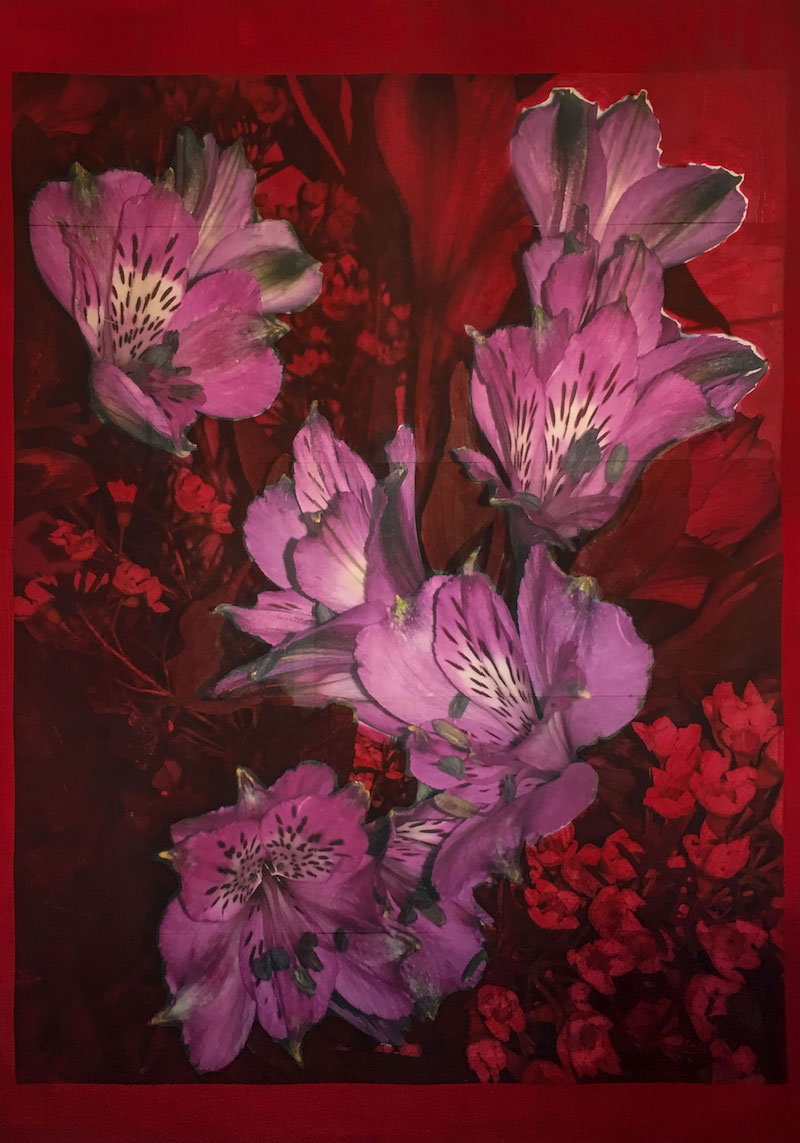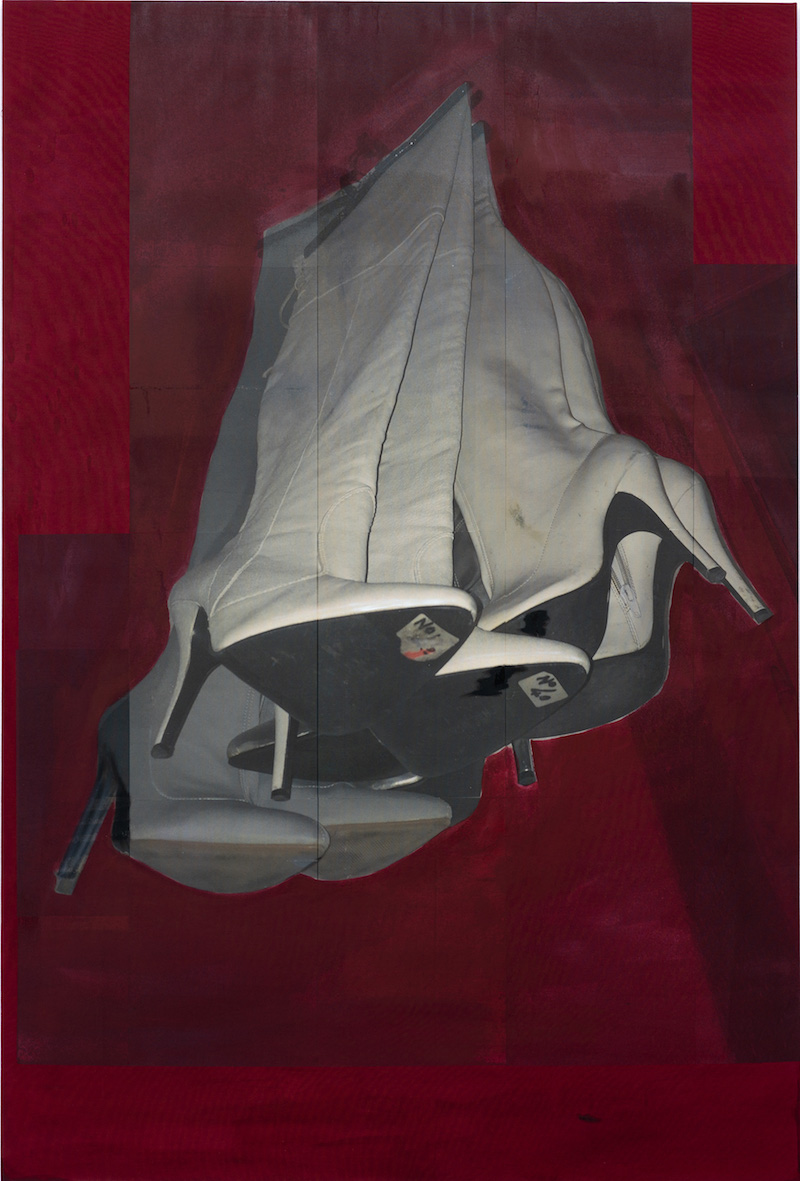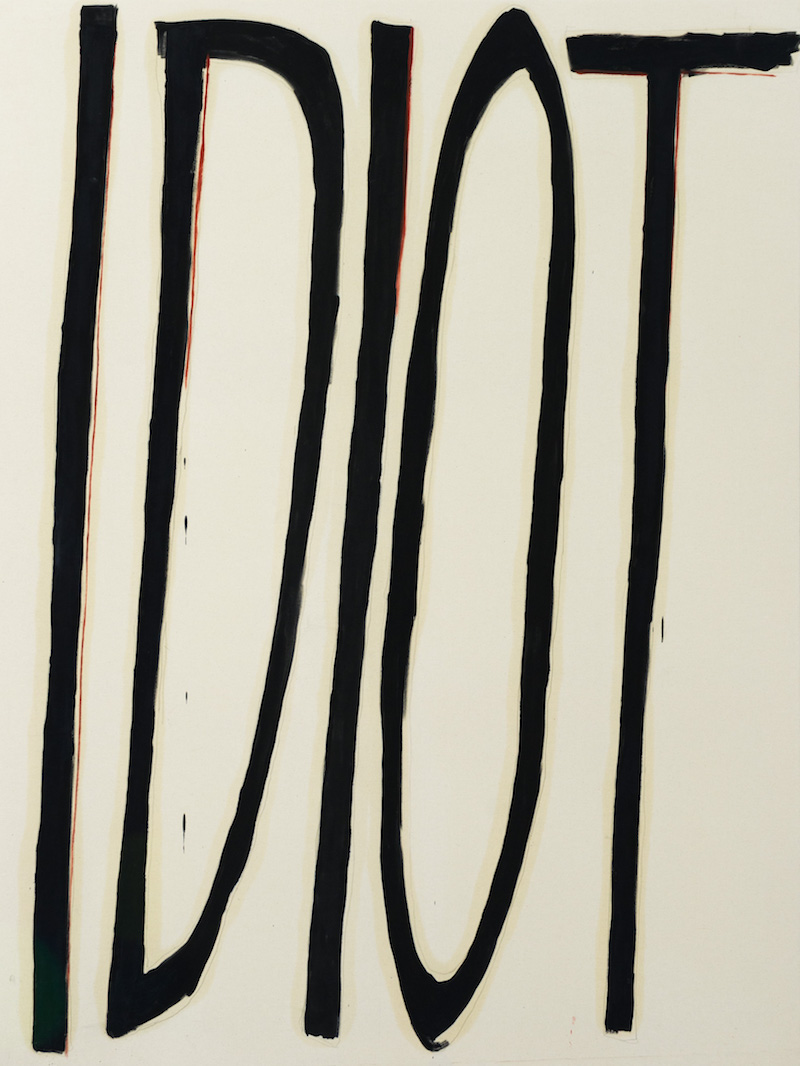
SI Chief Curator Laura McLean-Ferris talks to Tobias Spichtig, who will have an exhibition at SI in 2021, about three paintings from his exhibition Love and Die at Synagogue de Delme in 2019.
Laura McLean-Ferris: I want to start off with the flower paintings, Blumen rechts and Linke Blumen (Rechte Blumen) (all works 2019) which are large canvases with printed photographs of a bunch of pink freesias. Excluding the central focus of the blooms, the backdrop of the painting, along with some of the flowers that fade into background, has been painted over in a red wash. Given the title of the exhibition Love and Die, I wanted to ask about the excess of sincerity, even melodrama, in the title, and how a bouquet of flowers fits into that symbolic realm of things that are overburdened with meaning: overdone, cliché, or maybe just ordinary?
Tobias Spichtig: It’s both. The flowers could also be squares but I liked the flowers more. Then again, isn’t it amazing that flowers on canvas with a bunch of words can mean so much and nothing at the same time? I mean, who doesn’t like flowers? But then again, it can be so hard to choose the right flowers for the right occasion. I specifically like these flowers on a red background. The red of the background is very specific. As specific as the red of a certain lipstick from a certain time, a fridge or a pair of sunglasses. There are so many great reds in lipsticks, which I like to buy but never wear. But it’s not about why exactly this red or why these flowers. It’s more about how than why. Love and Die is sort of a basis for politics, or the economy etc. Even zombies and vampires want to love and die, but they seem to find love more easily than death.
LMF: With this ‘lipstick red’ around the flowers, are you thinking of adding an industrial color to a photograph so that it has a background and reads more like design or a product in a certain respect?
TS: Not really. I just wanted to make a painting of these flowers. I’m not so interested in the fetish of technology nor craft. I’m probably more focused on making paintings, than performing the act or process of painting. But yes, so far I mostly used vinyl prints of snapshots and oil paint. It’s simple and easily available and it makes sense for these paintings. What I mean about the lipstick is that they invent very specific reds. Just reds. And they give them names. They treat reds like objects and make them into subjects. (Painting does the opposite.)


LMF: In another piece in this show, an image of a large collection of high heeled white boots was given this treatment. Can you talk about how themes relating to fashion and style play a part in your work?
TS: These are boots hanging from a coat hanger of a friend of mine. Her collection also inspired the first sunglasses paintings, in parallel with Visioni Dei by niklas van keys. The boots looked like they’d walk over you when I took the picture. We were neighbors at the time and she had an amazing collection of garments which I found very inspiring. So the title is “the boots of the neighbor.” I’m not particularly interested in fashion or style. It is more the material that surrounds me.

LMF: I wanted to ask about your text painting, ‘IDIOT’. The dark letters of this word are elongated and stretched vertically, so they are tall and skinny. The combination of the word and the funhouse mirror quality of the lettering renders them somewhere between silly and threatening, like a tall, thin goon from an old comedy film or animation. The letters somewhat resemble your sculptural figures made of clothes, that similarly seem emaciated. Can you tell me more about the IDIOT figure here, where this comes from, and any possible relationship to historic ‘idiots’ from film and literature – Dostoevsky’s The Idiot, Godard’s Pierrot Le Fou, The Farrelly Brothers Dumb and Dumber. etc?
TS: I like the figure of the idiot and especially the one from Dostoevsky. It starts exactly like the communist revolution with a train ride from Switzerland to Russia. The idiot has something that everyone can relate to. (I also thought about the difference between idiocy and stupidity.) The font comes from these single words and how they look. A bit like a word that becomes almost detached from the meaning intended when you say it several times and think how strange this sounds.
LMF: Can you talk about your use of everyday items in exhibitions. You have previously used mattresses, fridges, air conditioning units. In this case, household lamps? How do these works tie together a show for you?
TS: I moved a lot and these lamps were always left behind because they’re everywhere. I started collecting them. It’s a standard design and the designers are now unknown but they can be very beautiful. The double function of the reading light and the flood light to the ceiling are almost a symbol for perception, the home or all other connotations. Like reading and then looking at the room, while trying to make some sense of the situations. The accumulation of these objects makes them abstract and somehow iconic.
Images (in order of appearance): Blumen rechts, 2019. Vinyl Print and Oil on Canvas. 200 x 140cm. Ich weiss leider nicht, wie ich all das erklären soll., 2019. Oil and vinyl print on canvas. 205 x 150 cm. Die Stiefel der Nachbarin, 2019 Oil and vinyl print on canvas. 185 x 125 cm. Idiot, 2018. Oil on canvas. 200 x 150 cm.
